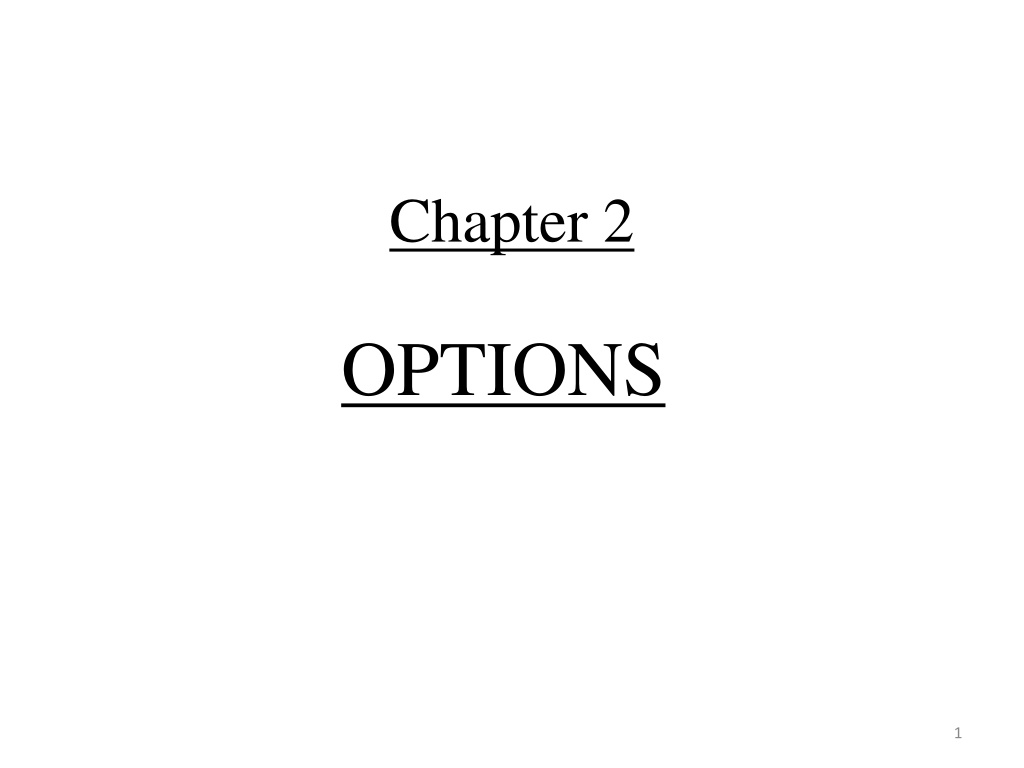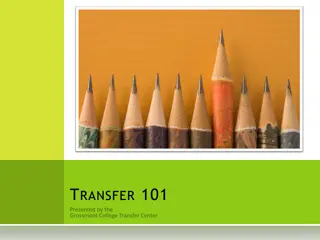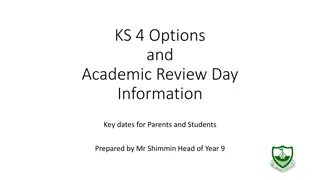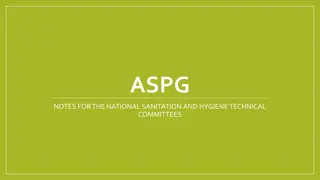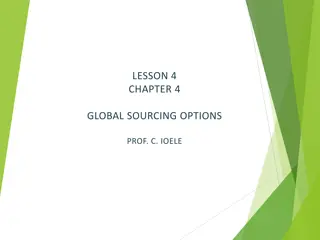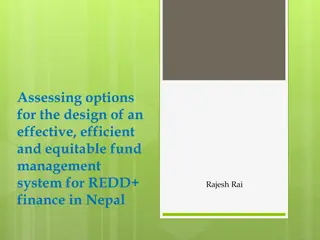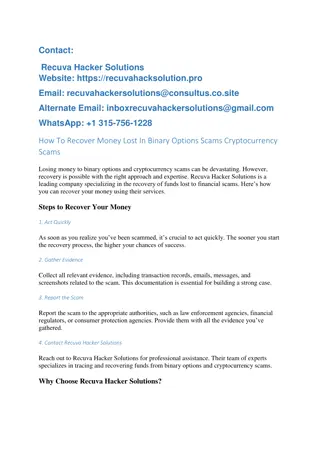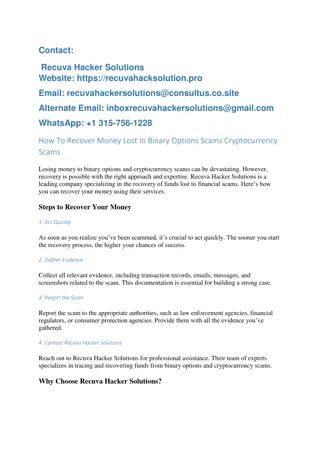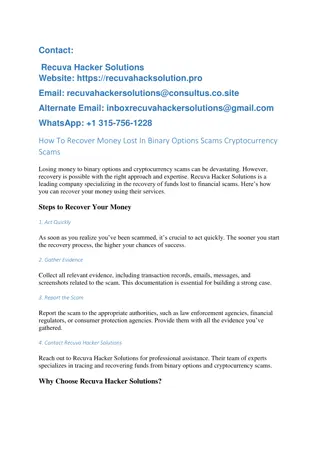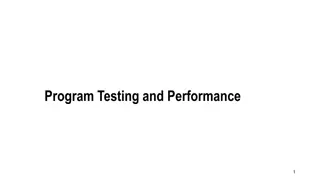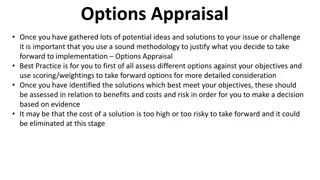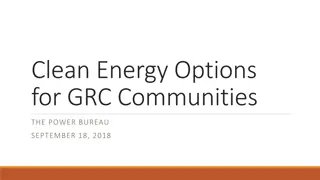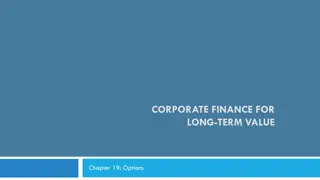OPTIONS
In this section, we delve into the various options available, offering detailed insights and perspectives on the choices at hand. Explore the opportunities presented and gain a comprehensive understanding of the possibilities awaiting you.
Download Presentation

Please find below an Image/Link to download the presentation.
The content on the website is provided AS IS for your information and personal use only. It may not be sold, licensed, or shared on other websites without obtaining consent from the author.If you encounter any issues during the download, it is possible that the publisher has removed the file from their server.
You are allowed to download the files provided on this website for personal or commercial use, subject to the condition that they are used lawfully. All files are the property of their respective owners.
The content on the website is provided AS IS for your information and personal use only. It may not be sold, licensed, or shared on other websites without obtaining consent from the author.
E N D
Presentation Transcript
Chapter 2 OPTIONS 1
In chapter 1 we introduced the concept of an option, a contract between two parties-a buyer and a seller, or writer-in which the buyer purchases from the writer the right, but not the obligation, to buy or sell an asset at a fixed price on or before a specified date. 2
As in any contract, each party grants something to the other. The buyer pays the seller a fee called the premium, which is the option s price. The writer grants the buyer the right to buy or sell the assets at a fixed price. 3
An option to buy an asset is a call option. An option to sell an asset is a put option. The fixed price at which the option buyer can either buy or sell the asset is called the exercise price or strike price. In addition the option has a definite life. The right to buy or sell the asset at a fixed price exists up to a specified expiration date. 4
Options are often encountered in everyday life Suppose you plane to purchase a deeply discounted airline ticket. You are afraid your plans might change, and the airline says the ticket at that price is nonrefundable. For just $75 more, you can obtain the right to cancel the ticket at the last minute. If you pay the extra $75 for the right to cancel, you have just purchased an option. 5
Development of Options Markets Little is known about the options world of the 1800s. In the early 1900s, a group of firms calling itself the Put and Call Brokers and Dealers Association created an options market. 6
If someone wanted to buy an option, a member of the association would find a seller willing to write it. If the member firm could not find a writer, it would write the option itself. Thus, a member firm could be either a broker-one who matches buyer and seller-or a dealer-one who actually takes a position in the transaction. 7
This over-the-counter options market viable, it suffered from several deficiencies. - First it did not provide the option holder the opportunity to sell the option to someone else before it expired.(little or no liquidity) - Second the writer s performance was guaranteed only by the broker-dealer firm. In the case of bankrupt, the option holder suffered a credit loss. - Third the cost of transacting was relatively high. 8
In 1973, a revolutionary change occurred in the options world. The Chicago Board of Trade, the world s oldest and largest exchange for the trading of commodity futures contracts, organized an exchange exclusively for trading options on stocks. The exchange was named the Chicago Board Options Exchange ( CBOE). 9
It opened its doors for call option trading on 1973, and the first puts were added in 1977. The CBOE created a central marketplace for options. By standardizing the terms and conditions of option contracts, it added liquidity. CBOE added a clearinghouse that guaranteed to the buyer that the writer would fulfill his end of the contract. This made options more attractive to the general public. 10
Options Types 1- Call option: Is a financial contract between two parties, the buyer and the seller of this type of option. The buyer of the call option has the right, but not the obligation to buy an assets, from the seller of the option at a certain time (the expiration date) for a fixed price (the exercise-strike price). The seller (or "writer") is obligated to sell the assets to the buyer if the buyer so decides. The buyer pays a premium for this right. 11
Example: On August 1,2005 several exchanges offered options on the stock of Microsoft. One particular call option had an exercise price of $27.5 and an expiration date of September 16. Microsoft stock had a price of $25.92. 12
The buyer of this option received the right to buy the stock at any time up through September 16 at $27.5 per share. he has expected that the stock s price would rise above $27.5 before the option expired. The call writer was obligated to sell the stock at $27.5 per share through September 16 whenever the buyer wanted it and conversely, he expect that the stock price would not get above $27.5 before the option expired. 13
For this privilege, the buyer paid the writer the premium, or price of $0.125 (as wager). Analyze the buyer of this option situation if the price was: 1- Higher than $27.5 2- Less than $27.5 14
A call in which the stock price exceeds the exercise price is said to be in-the-money. ( calls should be exercised) If the stock price less than the exercise price the call option is said to be out-of-the-money. ( calls should never be exercised) If the stock price equals the exercise price the option is at-the-money 15
Options Types 2- Put option: Is an option to sell an assets, such as stock. Example: Consider the put option on Microsoft stock on August 1,2005 with exercise price of $27.5 and an expiration date of September 16, stock price $25.92. 16
The put holder could have elected to exercise the option, selling the stock to the writer for $27.5 per share or may be have preferred to wait and see if the stock price fell further below the exercise price. The put buyer expected the stock price to fall, while the writer expected it to remain the same or rise. 17
The put option buyer and writer negotiated a premium of $1.70, which the buyer paid to the writer. This premium can be viewed as the buyer s wager that the stock price would not rise above $27.5 per share by September 16. The put writer accepted the premium because it was deemed to be fair compensation for the willingness to buy the stock for $27.5 any time up through September 16.(Why would either party have entered into the option contract?) 18
Since the put allows the holder to sell the stock for a fixed price, a decrease in the stock price will make the put more valuable. Conversely, if the stock price increases, the put will be less valuable. It should be apparent that the buyer of a put has bearish expectations for the stock. 19
If the stock price is less than the exercise price the put is said to be in-the-money. If the stock price is more than the exercise price the put option is out-of-the-money. If the stock price equals the exercise price the option is at-the-money. 20
Type of Option According to the Trading Markets 1. Over-the-counter options (OTC options, also called "dealer options") are traded between two private parties, and are not listed on an exchange. The terms of an OTC option are unrestricted and may be individually tailored to meet any business need. 21
Major Advantages of Over-the-Counter Options Market 1. The terms and conditions of the option can be tailored to the specific needs of the two parties. 2. The over-the-counter market is a private market in which neither the general public nor other investors, including competitors, need know that the transactions were completed. This dose not mean that transactions are illegal or suspicious. 22
3. Over-the-counter trading is essentially unregulated. Its rules are those of commonsense business honesty and courtesy. 23
Disadvantage to Over-the-Counter trading 1. Credit risk is higher and excludes many customers who are unable to establish their creditworthiness in this market. 2. The size of the transactions in the over-the-counter market are larger than many investors can handle. 3. This market is quite large, but because of the private nature of the transactions, gauging its size is difficult. 24
Most of the options created on the over-the-counter market are not the traditional case of an option on an individual common stock. they tend to be options on bonds, interest rates, commodities, swaps and foreign currencies and include many variations that combine options with other instruments. 25
2. Exchange-traded options (also called "listed options") are a class of exchange-traded derivatives. Exchange traded options have standardized contracts, and are settled through a clearing house with fulfillment guaranteed by the Options Clearing Corporation (OCC). 26
Option Traders In over-the-counter market, certain institutions, which may be banks or brokerage firms, stand ready to make markets in options. Exchange-listed options of course, are created on an exchange, which is a legal corporate entity whose members are individuals or firms. Each membership is referred to as a seat. The following sections discuss the types of traders who operate both on and off the exchange floor. 27
Option Traders This system of traders is based on the market maker system used by CBOE(Chicago Board Options Exchange). The following sections discuss the types of traders who operate both on and off the exchange floor. This system of traders is based on the market maker system used by CBOE. 28
Option Traders Market Maker An individual who has purchased a seat on the CBOE can apply to be either a market maker or a floor broker. The market maker is responsible for meeting the public's demand for options and offers the public the convenience of immediate execution of trades. 29
The market maker is essentially an entrepreneur. To survive, the market maker must profit by buying at one price and selling at a higher price. One way this is done is by quoting a bid price and an ask price. 30
The bid price is the maximum price the market maker will pay for the option. The ask price is the minimum price the market maker will accept for the option. The ask price is set higher than the bid price. The difference between them is called the bid-ask spread. 31
Option Traders Floor Broker Is another type of trader on the exchange. The floor broker executes trades for members of the public. If someone wishes to buy or sell an option, that individual must first establish an account with a brokerage firm. 32
Types of Option Two popular types of options are stock options and index options. 1.Stock Options Options on individual stocks are sometimes called equity options. 2.Index Options A stock index is a measure of the overall value of a designated group of stocks. 3.Currency options. 4.Real option. 34
Option Styles Naming conventions are used to help identify properties common to many different types of options. These include: European option an option that may only be exercised on expiration. American option an option that may be exercised on any trading day on or before expiry. 35
